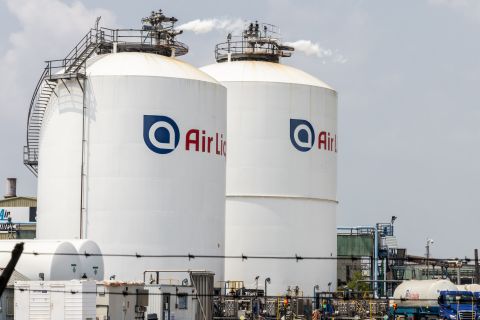Presented by:
[Editor's note: A version of this story appears in the July 2021 issue of Oil and Gas Investor magazine. Subscribe to the magazine here.]
For an industry less than a decade into its development, water management has emerged as a crucial component of upstream oil and gas development. And, in those seven years, the water management sector has seen remarkable growth and evolution.
In many cases, producers have created subsidiaries solely for their water management operations. Some have even sold them to third-party providers. The water management industry started simply as a means to acquire freshwater for fracking and dispose the vast amounts of produced water. Its evolution has included the development of hundreds of miles of gathering and distribution pipelines, primarily in the water-starved Permian Basin, and the creation of reliable and secure water sources.
And, like every other facet of the oil and gas industry, water management has now matured to the point of automation and the adoption of digital technologies that make water acquisition, disposal, reuse and recycling more efficient than ever.
Now, as a result of the diminishing value of saltwater disposal (SWD) wells— both environmentally and economically—companies are increasingly turning to water reuse and recycling for their fracking operations. SWD availability is becoming scarce, and induced seismicity concerns are pushing producers to turn to recycling.
In May, Hart Energy hosted a virtual water management conference, bringing together industry leaders who shared their insights on the latest trends and choices. Among them were John Durand, president and chief sustainability officer of XRI Holdings; Steve Jones, CEO of WaterBridge Resources LLC; and Brent Halldorson, president of RedOx Systems and board member of the Produced Water Society.
These industry leaders discussed the continued growth of the water management industry and the increased need for recycling. To view their full interviews and others from the Water Management Conference, visit hartenergyconferences.com/water-management-conference.
The Water Wall
Industry leader in water management says water production will continue to grow as production climbs and the need for increased recycling efforts gains steam.
The “wall of water” described by water management players is here and is likely to only continue growing, said John Durand, president and chief sustainability officer at XRI Holdings. Durand spoke of the urgent need for producers to adopt water recycling practices to limit disposal costs and meet growing calls for ESG efforts.

“Concerns regarding the use and supply of fresh water, seismicity and the safe storage of produced water are establishing strong tailwinds for the water recycling and reuse business model,” he said. “There undoubtedly lies a pathway and a significant market opportunity for gathering, treatment and redeployment of produced water resources.”
According to Durand, total Permian Basin oil production on March 1 was 4.3 million barrels per day (MMbbl/d), a year-over-year increase of 10.3%. Assuming what Durand called a “conservative” factor of 3.2 times oil-to-water ratio in the Permian Basin, approximately 14 MMbbl of flowback water are produced every day, or annualized estimated volume of 5.1 Bbbl.
“Even at reduced production … the wall of water we have experienced and talked about as a water management sector for years is alive and well,” he said.
Recycling efforts
Durand explained that E&P operators are increasingly focused on partnering with water midstream providers that are able to provide ESG-centric solutions to produced water management. He said the benefits to taking such an approach are “considerable.” Among the benefits to adopting larger-scale water recycling operations is creating a more cost-effective supply.
“Injecting produced water back into ground is extremely costly,” Durand said. “And scaled recycling now is a less expensive manner of which to dispose and utilize produced water.”
He added that the sustainability that water recycling affords benefits the oil and gas industry as a whole, where the industry can demonstrate higher environmental standards while driving customer value.
“In meeting customer needs without compromising the ability of future generations to meet their needs and demands should be our No. 1 goal,” Durand said.
Durand cited recent laws in New Mexico that ban the use of fresh water for fracking operations. In 2019, nearly 14.5 billion gallons of water were used for overall production in 2019, “equal to the amount of water needed for household use for about 280,000 people, or about one-eighth of New Mexico’s population.”
“How far away may we be from this sort of action in Texas, particularly if we revisit the type of drought conditions experienced from 2010 to 2015,” he said. “It is certainly something that should be top-of-mind for each of us in the water management sector, and we must plan ahead for that today.”
‘Blue-sky’ View on Water
Rethinking the capabilities of produced water may prove to be beneficial.
Adjusting the perception of produced water—the large amounts of water that flow back with oil and gas, particularly in unconventional production—can help the industry better leverage it as a commodity rather than a waste.

That theory was presented by Brent Halldorson, president of RedOx Systems and board member of the Produced Water Society. Offering what he described as “a very blue-sky look” at the future of water management, Halldorson said the industry should work to change the narrative of how it refers to produced water.
“It really is a valuable resource,” he said. “Produced water is an entirely new resource that we are liberating.”
Halldorson acknowledged that although the industry has begun to more readily embrace recycling produced water for fracking, water treatment efforts are minimal, simply enough to take out the suspended solids in order to pump downhole again.
“If fracking stops, recycling stops,” he said. “But produced water doesn’t stop, disposal doesn’t stop. It has to go somewhere.”
That leaves millions of barrels of produced water to be disposed of, which is costly and increasingly discouraged by investors who place a value on ESG efforts.
Halldorson suggested that if producers instead treat produced water to a quality in which it can be used outside of the oil and gas industry, it could “sever the tie” to frac supply and offer producers fringe benefits such as reducing seismicity risks.
“When we think of a traditional oil and gas well, we think of two commodities: oil and gas,” he said. “And we’ve got this produced water that comes out. Produced water gets no respect. We’ve subsidized water to the point where we think water has no value because water has essentially been free in the past. We can change that if we start giving produced water a little bit more respect. So, let’s think of it as three commodities we are bringing up from the ground.”
Overcoming obstacles
Halldorson acknowledged that the biggest obstacle to treating produced water to a quality that it can be used outside of the industry is a financial one.
“Can we make the economics works?” he asked. “Because if we want to get this water from where it is today, which is being used within the oil field, and we want to treat it to the point where it is used outside the oil field, it is going to take a higher level of treatment.”
Halldorson added that in addition to the financial challenge, the industry would also need to overcome both the public perception of produced water—and fracking, in general—as well as regulatory agencies such as the National Pollutant Discharge Elimination System.
He noted several efforts that have been successful in applying water produced from oil and gas production for non-industry applications. One is Eureka Resources in Pennsylvania, which Halldorson said was the first company to treat Marcellus Shale produced water to a standard for discharge. The company has improved its systems to create “true zero-liquid discharge” from produced water, he said, and can create food-grade quality salt for non-food applications and discharge distilled water back to the environment for reuse.
“We don’t have oil wells anymore,” Halldorson said. “We should really refer to them as oil, gas and water wells.”
Midstream H20
The water midstream sector continues its upward trajectory as producers turn more to third-party providers for water management.
While many companies are holding flat on production growth, focusing instead on generating cash, others are pushing ahead with guidance in the coming year of 10% growth in some cases and 3% and 5% for others. That production growth will lead to substantial increases in produced water volumes, necessitating increased investment and utilization of large-scale water midstream operations in the Permian Basin, said Steve Jones, co-CEO and CFO at WaterBridge Resources LLC.

WaterBridge Resources began with about 3,000 dedicated acres in the Delaware Basin in 2017 and now holds about 55,000 dedicated acres with 840 miles of pipeline and about 200,000 bbl/d of water handling capacity.
“Our evolution really mirrors the evolution of the producer side of the business,” he said. “Where producers once thought of water as being very integrated into their field operations that they couldn’t allow a third-party to handle it. Over time, the increases in water volumes have created constraints on their side, and we’ve seen the rise of third-party providers like WaterBridge to provide flow assurance and redundancy that is benefitting their businesses and allowing them to focus on the upstream side of their business.”
Water midstream rises
Jones explained how the growth in the water midstream business, and for WaterBridge Resources, has occurred when producers target production growth of their own.
“The water volumes, because of the initial flowbacks being so large, end up growing much more rapidly than the crude oil does,” he said.
Jones cited an example of a recent Wolfcamp B four-well pad that produced nearly 14,000 bbl/d of flowback water in its first two months online compared to just less than 2,000 bbl/d of oil. Those amounts quickly fall off, down to about 3,000 bbl/d of flowback water after about 18 months online, according to WaterBridge.
“At 5% growth target for crude oil today, which is the average for producers that are providing public guidance, it results in a mid-teens growth over the same time in water volumes,” Jones said. “[Producers] are having to invest a lot more in infrastructure for water than they would have previously. And, it makes the benefits greater for having a third-party service provider that they can trust.”
He added that such strong initial volumes of water make handling such quantities via truck “almost impossible,” and that operators should be connected to a water pipeline network.
“But also, if you’re getting into manufacturing mode as many producers are, those peak volumes will be much, much greater,” he said. “You have a hard time justifying building a small system for the peak volume for a producer when they are going to develop and move on.”
Jones explained that with the advent of cubestyle pad development, an operator’s peak daily water production rate could be as much as 220,000 bbl/d of water, which would require the development of about eight new saltwater disposal wells and associated facilities at a cost about $27 million.
And according to WaterBridge Resources, at market-based pricing, an operator realizes capex savings with only a slight increase in average monthly LOE.
“We and some of our peers have really figured out that the best way to think about a system for water management is less of a gathering and disposal system and more of a distribution system,” Jones said.
“As recycling has become a much more desirable part of the operations, taking back produced water that has been moderately treated and reusing that in completion activities can create a cycle that benefits everyone along the value chain.”
Recommended Reading
Humble Midstream II, Quantum Capital Form Partnership for Infrastructure Projects
2024-01-30 - Humble Midstream II Partners and Quantum Capital Group’s partnership will promote a focus on energy transition infrastructure.
Air Products Sees $15B Hydrogen, Energy Transition Project Backlog
2024-02-07 - Pennsylvania-headquartered Air Products has eight hydrogen projects underway and is targeting an IRR of more than 10%.
ConocoPhillips EVP of Strategy, Sustainability, Technology Macklon to Retire
2024-02-16 - Dominic Macklon, who began his career with Conoco in 1991, is set to retire ConocoPhillips May 1.
Air Liquide Eyes More Investments as Backlog Grows to $4.8B
2024-02-22 - Air Liquide reported a net profit of €3.08 billion ($US3.33 billion) for 2023, up more than 11% compared to 2022.
Green Swan Seeks US Financing for Global Decarbonization Projects
2024-02-21 - Green Swan, an investment platform seeking to provide capital to countries signed on to the Paris Agreement, is courting U.S. investors to fund decarbonization projects in countries including Iran and Venezuela, its executives told Hart Energy.






